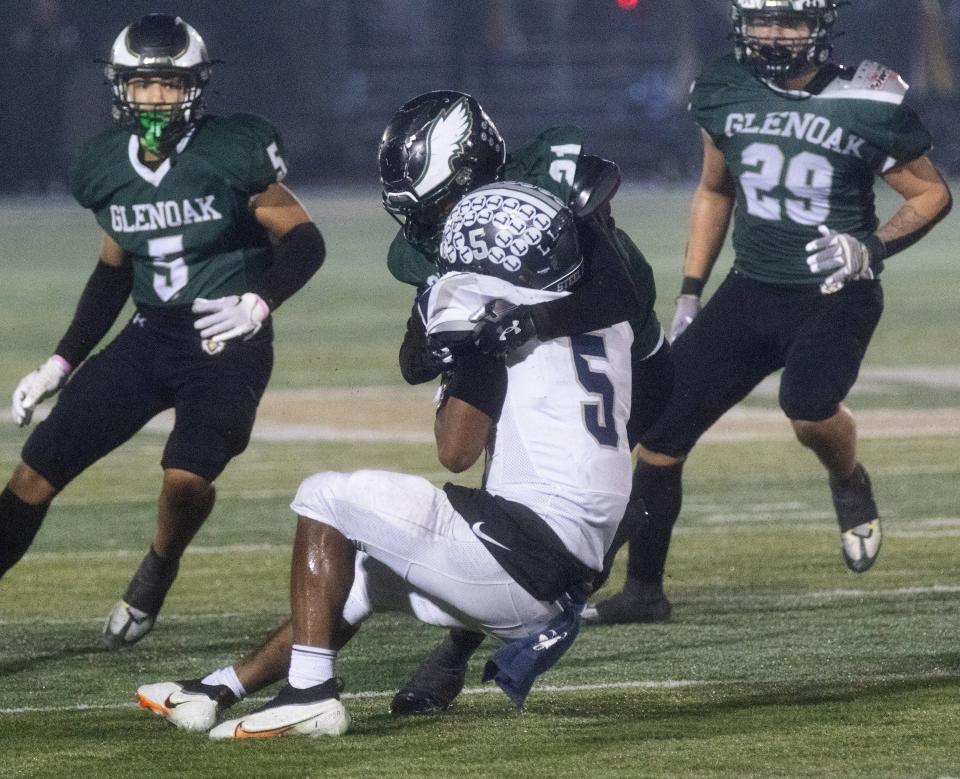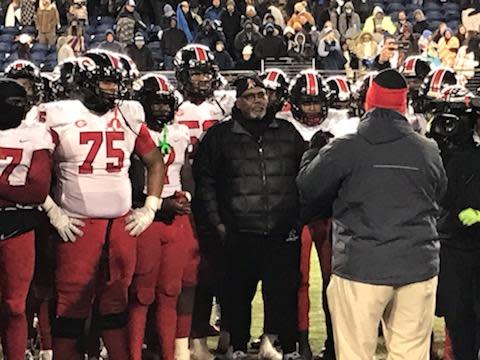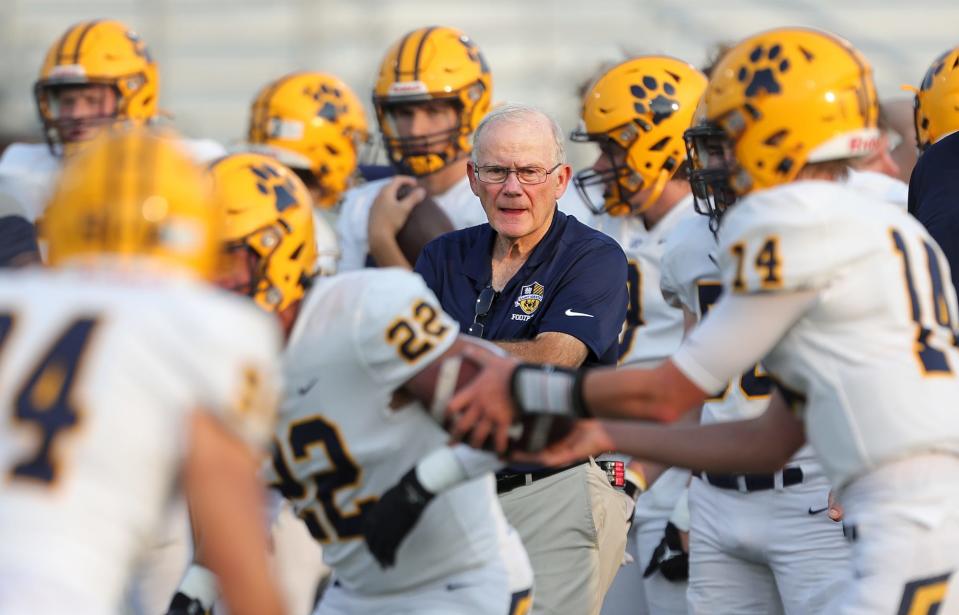7-on-7 football is here in the spring; how do schools keep the bad pieces of it out?

Editor's note: This is the third in a four-part series on 7-on-7 football. We'll look at how 7-on-7 came to Ohio and how it can coexist with spring sports. The series will also look at how to keep bad seeds out of the game and whether or not spring football is the next step.
Now that 7-on-7 football is here, how do you keep the bad aspects of the game from seeping in?
While there is good to AAU basketball, ODP soccer and JO volleyball, there is also an unfortunate side to the game.
The onus now falls on schools to make sure those who take advantage of the system stay out of 7-on-7 events and don’t mislead the student-athletes.
7-on-7 Football Part 1: Northeast Ohio high school football instrumental in bringing 7-on-7 to spring sports
7-on-7 Football Part 2: With 7-on-7 football now on the spring landscape, how will spring sports be impacted?
“It's probably good for the kids if it's done in the right way,” GlenOak football coach and athletic director Scott Garcia said. “To be able to go out and compete and get involved in some of those tournaments and get exposed to different things is great, but if it's with the wrong people or somebody's doing it to recruit, then obviously it could get out of control.”
Therein is the biggest concern of the club aspect of things.
It’s not that there aren’t positives from it. It’s the uneducated individuals entering the landscape.
“I would hate to see club programs overtake high school sports,” Nordonia athletic director Rob Eckenrode said. “High school sports are designed to teach citizenship skills versus club sports programs are to create scholarship athletes.”
How do schools protect athletes from the money-hungry 7-on-7 organizers?
The struggle to keep 7-on-7 in schools could also become harder with “all-star” events popping up run by organizers who are in it for the money.
While they claim to be running an elite tournament, it could be nothing more than the Brush junior varsity team coming in, one athletic director said.
“I think the waters are really muddy,” Wadsworth football coach Justin Todd said. “This almost feels like it was thrown up against the wall — let's see how it sticks. It's kind of the way things are taking place in sports these days, and I know that that's probably the reason why Ohio was late to the party with all this is because they were concerned about that AAU, JO model.
“But, again, everybody else does it. I think it's a great opportunity if you can get your teams to stay together and travel and play together in the offseason, then I think that's how you do it. It still is the ultimate team sport, and it's got to continue to be that way.”
Does 7-on-7 football teach bad habits and alienate certain positions?

What could make matters even worse is less qualified coaches coming in and teaching things that lead to bad habits.
On top of that, 7-on-7 limits teaching to just the skill positions and leaves everyone else out.
Glenville football coach Ted Ginn Sr. has been out in front of many of the changes in football, whether it’s taking his kids around the country at recruiting camps or making sure his Tarblooders and others get the most exposure they can.
That said, the two-time state champion still sees pitfalls that could arise in 7-on-7.
“I think it's bad for spring sports because you’ve got kids that should be running and they’re out doing 7-on-7 and aren’t with their teams,” he said. “First of all, everything in 7-on-7, you’re going to have to re-teach when it comes football time. In 7-on-7, they forget about the run, and that's not real football.
"The things that really bothers me though, far as Ohio goes, if you want to do something for spring, let's have spring football. That would be better so that we can develop kids even better. I don't see the development for football with 7-on-7. What about the other skills? What about the offensive line? What about the defensive line? We ain't doing nothing for them.”
Walsh football coach Nick Alexander said he worries 7-on-7 will take away from what high school sports means.
There’s merit to that as well, as sports like soccer, baseball, softball and volleyball rely more at the club level than they do in high school in terms of playing at the next level.
While those days don’t exist now, they could down the road.
“That's definitely a concern,” Alexander said. “It's just helping these kids keep their head on straight, that their high school season is still the most important thing to them. Because I think sometimes in other sports, their club team — whether it be a soccer club team or a summer baseball team — become a major priority where it almost does the school season a disservice.”
Will super teams in high school exist as a product of 7-on-7 football?
There’s also the plight of keeping students together at the same school.
While only seven players can be on the same team and be coached by someone from their school, who is to say an elite team of individuals from multiple schools don’t start think about the what ifs? Those individuals could get to talking about playing together at the same school, and the next school year they’re all together.
Coaches talk all the time about being the biggest cheerleader for their schools in the hopes of keeping a team intact.
Would 7-on-7 take away from that ideology?
“I'm not in favor of guys joining super team 7-on-7s just for the purposes of flying out of town for a tournament or doing those type of things because now you're taking away from the time that I thought we were getting back,” Akron East coach Marques Hayes said. “What the southern states are able to do when they're having spring football, actual practices with pads on and things like that. We have numerous scouts that come up here all the time and they say, ‘Hey, we're going down to Georgia. They got padded football practice day after school and stuff like that.’ So they're doing these things as a team.”
How much is too much football when it comes to high school sports?

The last worry is burnout.
St. Ignatius coach Chuck Kyle is a legend as a football and track coach in Ohio.
With what is going on in the specialization of sports, he said he worries that the future of niche sports are in jeopardy.
“A lot of the guys that are making money and they'll turn to this one kid and it costs how many thousands of dollars to be on this team, but then the kid who's really good, that kid hardly pays anything,” he said. “That's what goes on, for sure. You're bringing in that element as soon as you start doing that sort of thing.
"And parents, they travel around, and I think they like it for a while. They're spending a heck of a lot of money and blowing their weekends, and typically the kid burns out.”
Contact Brad Bournival at bbournival@gannett.com and follow him on Twitter at @bbournival
This article originally appeared on Akron Beacon Journal: How can we keep bad elements of 7-on-7 football out of spring sports?

